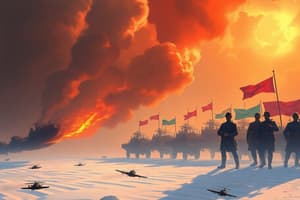Podcast
Questions and Answers
What countries were part of the Triple Alliance?
What countries were part of the Triple Alliance?
Germany, Austria-Hungary, Italy
Which countries formed the Triple Entente?
Which countries formed the Triple Entente?
Britain, France, Russia
What was one of the main concerns for Germany in 1905?
What was one of the main concerns for Germany in 1905?
- Losing Alsace-Lorraine to France (correct)
- Expanding its territory to the east
- Strengthening its naval forces
- All of the above
Britain was involved in European politics during the 19th century.
Britain was involved in European politics during the 19th century.
The main concern of the Austrian emperor was to keep the empire ______.
The main concern of the Austrian emperor was to keep the empire ______.
What prompted Russia to support Serbia against Austria-Hungary?
What prompted Russia to support Serbia against Austria-Hungary?
What was a significant consequence of the rivalry between Britain and Germany?
What was a significant consequence of the rivalry between Britain and Germany?
What did France seek to achieve regarding Germany in 1905?
What did France seek to achieve regarding Germany in 1905?
Italy was a strong industrial power in 1905.
Italy was a strong industrial power in 1905.
Why did Austria-Hungary and Russia become rivals?
Why did Austria-Hungary and Russia become rivals?
Flashcards are hidden until you start studying
Study Notes
The Alliance System
- The alliance system in Europe was formed as a way for countries to protect themselves from rivals, particularly after a long period of wars and competition.
- The alliance system consisted of two main groups – the Triple Alliance and the Triple Entente.
- The Triple Alliance was formed by Germany, Austria-Hungary, and Italy.
- The Triple Entente was formed by Britain, France, and Russia.
- The alliance system was seen by some as promoting peace, but others saw it as making war more likely.
- Tensions deepened over time, leading to the outbreak of war in 1914 and the rise of the alliance system.
Great Powers and Their Grievances
- Six "Great Powers" existed in Europe at the beginning of the 20th century: Germany, Austria-Hungary, Italy, France, Russia, and Great Britain.
- Their common goals included seeking security from attack, expanding trade, and protecting their own interests.
Reasons for Tension in Europe
- Germany: Feared France would attack to reclaim Alsace-Lorraine, taken from France in the Franco-Prussian War, a key industrial area.
- Austria-Hungary: Worried about its large multicultural empire falling apart, especially with growing Serbian nationalism, supported by Russia.
- Italy: A new nation with a weak industrial and military force looked to alliances to enhance its power, joining the Triple Alliance as a way to be a part of a powerful group.
- France: Aiming to reclaim Alsace-Lorraine and prevent another German attack, France entered an alliance with Russia.
- Russia: Feared Germany's expansion in Central Europe and Austria-Hungary's suppression of Slavic populations, as both Russians and Serbs were Slavic peoples.
- Great Britain: Traditionally neutral in European politics, Britain adopted a policy of "splendid isolation."
Studying That Suits You
Use AI to generate personalized quizzes and flashcards to suit your learning preferences.




